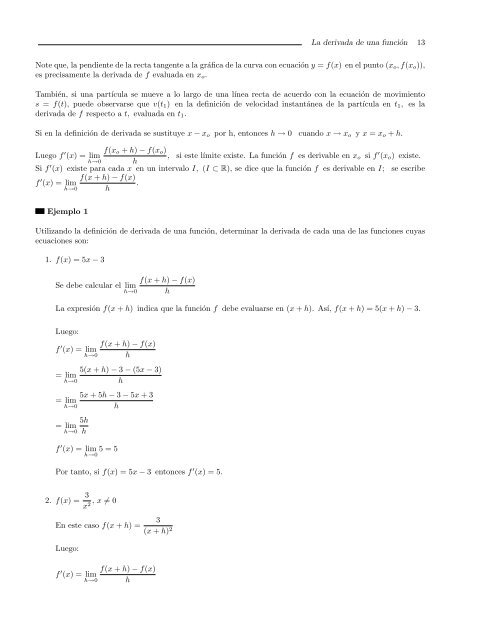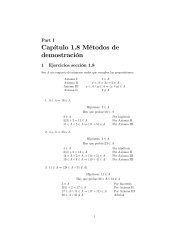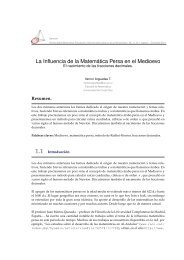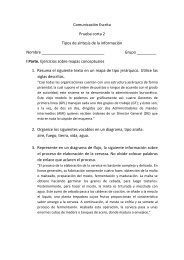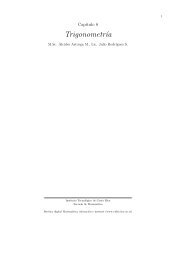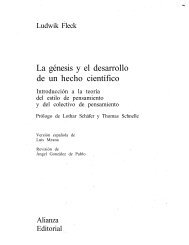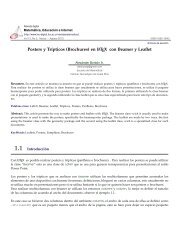Derivada de una función - TEC-Digital
Derivada de una función - TEC-Digital
Derivada de una función - TEC-Digital
You also want an ePaper? Increase the reach of your titles
YUMPU automatically turns print PDFs into web optimized ePapers that Google loves.
La <strong>de</strong>rivada <strong>de</strong> <strong>una</strong> <strong>función</strong> 13<br />
Note que, la pendiente <strong>de</strong> la recta tangente a la gráfica <strong>de</strong> la curva con ecuación y = f(x) en el punto (xo, f(xo)),<br />
es precisamente la <strong>de</strong>rivada <strong>de</strong> f evaluada en xo.<br />
También, si <strong>una</strong> partícula se mueve a lo largo <strong>de</strong> <strong>una</strong> línea recta <strong>de</strong> acuerdo con la ecuación <strong>de</strong> movimiento<br />
s = f(t), pue<strong>de</strong> observarse que v(t1) en la <strong>de</strong>finición <strong>de</strong> velocidad instantánea <strong>de</strong> la partícula en t1, es la<br />
<strong>de</strong>rivada <strong>de</strong> f respecto a t, evaluada en t1.<br />
Si en la <strong>de</strong>finición <strong>de</strong> <strong>de</strong>rivada se sustituye x − xo por h, entonces h → 0 cuando x → xo y x = xo + h.<br />
Luego f ′ f(xo + h) − f(xo)<br />
(x) = lim<br />
, si este límite existe. La <strong>función</strong> f es <strong>de</strong>rivable en xo si f<br />
h→0 h<br />
′ (xo) existe.<br />
Si f ′ (x) existe para cada x en un intervalo I, (I ⊂ R), se dice que la <strong>función</strong> f es <strong>de</strong>rivable en I; se escribe<br />
f ′ f(x + h) − f(x)<br />
(x) = lim<br />
.<br />
h→0 h<br />
Ejemplo 1<br />
Utilizando la <strong>de</strong>finición <strong>de</strong> <strong>de</strong>rivada <strong>de</strong> <strong>una</strong> <strong>función</strong>, <strong>de</strong>terminar la <strong>de</strong>rivada <strong>de</strong> cada <strong>una</strong> <strong>de</strong> las funciones cuyas<br />
ecuaciones son:<br />
1. f(x) = 5x − 3<br />
f(x + h) − f(x)<br />
Se <strong>de</strong>be calcular el lim<br />
h→0 h<br />
La expresión f(x + h) indica que la <strong>función</strong> f <strong>de</strong>be evaluarse en (x + h). Así, f(x + h) = 5(x + h) − 3.<br />
Luego:<br />
f ′ f(x + h) − f(x)<br />
(x) = lim<br />
h→0 h<br />
5(x + h) − 3 − (5x − 3)<br />
= lim<br />
h→0<br />
h<br />
5x + 5h − 3 − 5x + 3<br />
= lim<br />
h→0 h<br />
5h<br />
= lim<br />
h→0 h<br />
f ′ (x) = lim<br />
h→0 5 = 5<br />
Por tanto, si f(x) = 5x − 3 entonces f ′ (x) = 5.<br />
2. f(x) = 3<br />
, x = 0<br />
x2 En este caso f(x + h) =<br />
Luego:<br />
f ′ (x) = lim<br />
h→0<br />
f(x + h) − f(x)<br />
h<br />
3<br />
(x + h) 2


